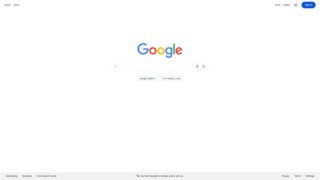
Google Search is a search engine owned and operated by Google. Handling more than 3.5 billion searches per day, it has a 92% share of the global search engine market. It is the most-visited website in the world. Approximately 26.75% of Google's monthly global traffic comes from the United States, 4.44% from India, 4.4% from Brazil, 3.92% from the United Kingdom and 3.84% from Japan according to data provided by Similarweb.
Spamdexing is the deliberate manipulation of search engine indexes. It involves a number of methods, such as link building and repeating unrelated phrases, to manipulate the relevance or prominence of resources indexed in a manner inconsistent with the purpose of the indexing system.

File Explorer, previously known as and still sometimes called Windows Explorer, is a file manager application and default desktop environment that is included with releases of the Microsoft Windows operating system from Windows 95 onwards. It provides a graphical user interface for accessing the file systems. It is also the component of the operating system that presents many user interface items on the screen such as the taskbar and desktop. Controlling the computer is possible without File Explorer running. After the name change that was introduced in Windows 8, Windows Explorer name can still be seen when you look for it in the Windows Task Manager.

Google News is a news aggregator service developed by Google. It presents a continuous flow of links to articles organized from thousands of publishers and magazines. Google News is available as an app on Android, iOS, and the Web.

Gmail is an email service provided by Google. As of 2019, it had 1.5 billion active users worldwide, making it the largest email service in the world. It also provides a webmail interface, accessible through a web browser, and is also accessible through the official mobile application. Google also supports the use of third-party email clients via the POP and IMAP protocols.
In blogging, a ping is an XML-RPC-based push mechanism by which a weblog notifies a server that its content has been updated. An XML-RPC signal is sent from the weblog to one or more Ping servers, as specified by originating weblog), to notify a list of their "Services" of new content on the weblog.

Google Base was a database provided by Google into which any user can add almost any type of content, such as text, images, and structured information in formats such as XML, PDF, Excel, RTF, or WordPerfect. As of September 2010, the product has been downgraded to Google Merchant Center.
Prospective search, or persistent search, is a method of searching which determines which of a set of queries matches content in a corpus. Other names include document routing and percolate queries. It is sometimes called reverse search, but that can also refer to finding documents similar to a given document.
Compared with previous versions of Microsoft Windows, features new to Windows Vista are very numerous, covering most aspects of the operating system, including additional management features, new aspects of security and safety, new I/O technologies, new networking features, and new technical features. Windows Vista also removed some others.
nofollow is a setting on a web page hyperlink that directs search engines not to use the link for page ranking calculations. It is specified in the page as a type of link relation; that is: <a rel="nofollow" ...>. Because search engines often calculate a site's importance according to the number of hyperlinks from other sites, the nofollow setting allows website authors to indicate that the presence of a link is not an endorsement of the target site's importance.
Feedburner, Inc. is a web feed management service primarily for monetizing RSS feeds, primarily by inserting targeted advertisements into them. It was founded in 2004 and acquired by Google in 2007.

This article details features of the Opera web browser.
Google Search Console is a web service by Google which allows webmasters to check indexing status, search queries, crawling errors and optimize visibility of their websites.
Some of the new features included in Windows 7 are advancements in touch, speech and handwriting recognition, support for virtual hard disks, support for additional file formats, improved performance on multi-core processors, improved boot performance, and kernel improvements.

Chromium is a free and open-source web browser project, primarily developed and maintained by Google. This codebase provides the vast majority of code for the Google Chrome browser, which is proprietary software with additional features.

Google+ was a social network that was owned and operated by Google until it ceased operations in 2019. The network was launched on June 28, 2011, in an attempt to challenge other social networks, linking other Google products like Google Drive, Blogger and YouTube. The service, Google's fourth foray into social networking, experienced strong growth in its initial years, although usage statistics varied, depending on how the service was defined. Three Google executives oversaw the service, which underwent substantial changes that led to a redesign in November 2015.

Android Ice Cream Sandwich is the fourth major version of the Android mobile operating system developed by Google. Unveiled on October 19, 2011, Android 4.0 builds upon the significant changes made by the tablet-only release Android Honeycomb, in an effort to create a unified platform for both smartphones and tablets. The first phone with Android Ice Cream Sandwich was Samsung Galaxy Nexus.
Social spam is unwanted spam content appearing on social networking services, social bookmarking sites, and any website with user-generated content. It can be manifested in many ways, including bulk messages, profanity, insults, hate speech, malicious links, fraudulent reviews, fake friends, and personally identifiable information.







